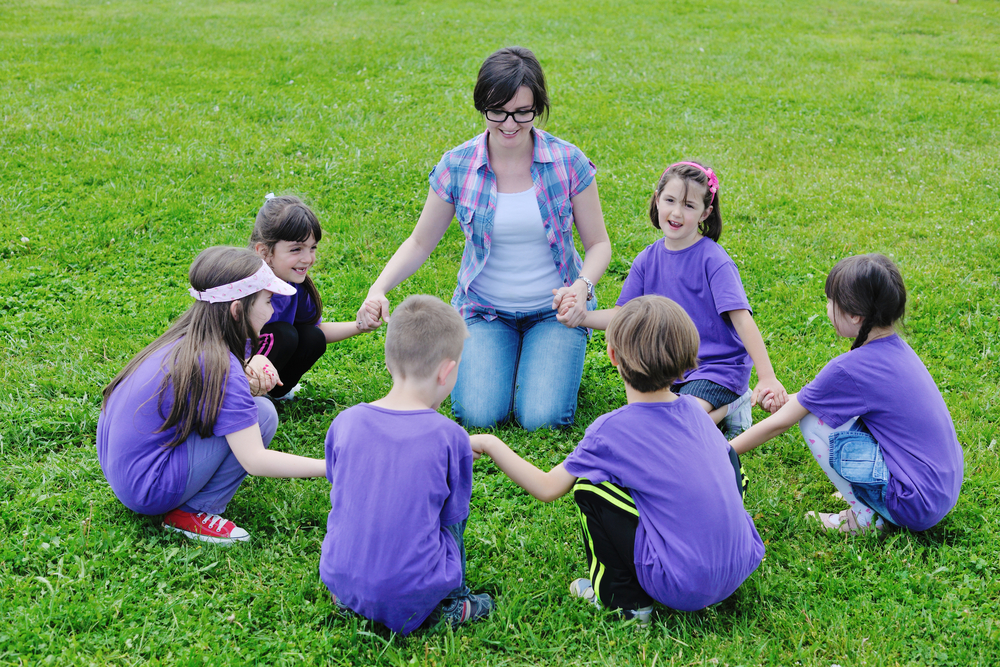Taking Education Outdoors: Classroom Lesson Ideas
Posted by May Recreation Content Team on

Even prior to the COVID-19 pandemic, educators understood the value of taking their students outdoors for learning experiences.
“A number of studies have documented increased school performance through outdoor education,” summarized a University of Wisconsin-Stevens Point (UWSP) research paper published a decade ago. “Research has documented increased standardized test scores, enhanced attitude about school, improved in-school behavior, improved attendance and overall enhanced student achievement when students learn in and about nature.”
Learning Outdoors is Healthy in COVID-19 Era
The UWSP research summarized the benefits of taking the classroom outdoors as:
- Supports child development
- Teaching and learning outdoors can be fun
- Learning outdoors helps foster a sense of place and civic attitudes
- Learning outdoors is healthy
“Outdoor learning and access to nature also decrease stress levels of students and teachers,” the research authors concluded.
During the COVID-19 pandemic, the health and reduced benefits of outdoor learning have never been greater as school districts attempt to keep staff and students healthy while keeping their curriculum on track.
“Seeking ways to teach safely during the pandemic, schools across the United States have embraced the idea of classes in the open air, as Americans did during disease outbreaks a century ago,” Amelia Nierenberg writes in The New York Times.
Best Practices for Outdoor Learning
In response to the pandemic, four organizations came together -- Green Schoolyards, Ten Strands, San Mateo County Office of Education and Lawrence Hall of Science at the University of California, Berkeley – to create the National COVID-19 Outdoor Learning Initiative.
A nearly 300-person volunteer force of public health officials, landscape architects, educators, and others, on behalf of the National COVID-19 Outdoor Learning Initiative have created a depository of resources and tools for outdoor classroom planners.
The National COVID-19 Outdoor Learning Initiative recommends the following best practices for outdoor learning:
- Prioritize science: Being outdoors lends itself to science so take advantage of the opportunities.
- Utilize outdoor spaces: Incorporate multiple outdoor learning areas into lessons.
- Consider staffing: Consider additional help of non-certified staff, temporary instructors, and volunteers to bolster outdoor staffing.
- Design at the margins: Design lesson plans for most vulnerable students.
- Prioritize communication: Establish regular and consistent channels of communication to staff, students, and parents.
Lesson Ideas for Outdoor Classrooms
When it comes to outdoor learning, the sky is truly the limit.
Here are some of our favorite outdoor learning ideas:
- ABCs and 123s Nature Way: You likely will not have a chalkboard outdoors, but you can still have fun teaching kids their ABCs and 123s by utilizing your outdoor environment. Consider having students trace letters and numbers in the dirt or sand if part of the outdoor learning area. Students can also be given cups to collect rocks, twigs, pinecones, and other items and then utilize these natural elements to create their letters and numbers on the ground.
- Create and Keep a Nature Journal: Have students create a nature journal where they can record all the interesting things outdoors that they see, smell, hear, and feel. Nature journaling combines writing and art with students describing things they find in paragraphs or stories, while also drawing pictures and sketches of their observations. Birds, insects, flowers, trees and even the weather are all prime material for nature journals.
- Start a School or Community Garden: There was a time in American education when community or school gardens at schools were a standard learning tool, especially in areas based on agrarian economy. Creating a raised bed garden can involve the learning of physical construction skills as well as teaching about planting, growing, cultivation, and nutrition. Green Schoolyards says that a “school garden can be used to teach all subjects in a hands-on, place-based way. In particular, school gardens provide a place to introduce life cycles and other biological processes, and they prompt discussions on ecology, recycling, and natural communities, supporting the development of a deep connection to the natural world.”
- Mural Painting: Bring your art class alive outdoors by creating a mural painting. The subject of your classes’ mural can be part of your curriculum in almost any area. Let the students design the mural and choose the location (with permission of the school!). Students will enjoy this outdoors hands-on project with a result that others will be able to see. Keep in mind that a blank wall isn’t needed to do a mural painting as the project can be done on sidewalks, blacktops, steps, columns, and other surfaces.
- Daily Nature Hikes: Keep your classroom moving, and your students exercised, with daily hikes around campus. Consider weekly or monthly longer hikes to nearby parks, recreations centers, and other community locales.
Contact May Recreation today to see how we can provide your greater Houston area project with a recreational design concept that emphasizes safety and fun.
